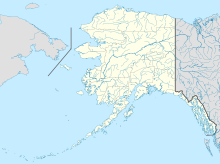Oil production in Alaska
The oil production in Alaska is a great of the US state of industry. After mercenaries found oil in Cook Inlet in 1891 , it began to be extracted from 1911. But it was only after the massive emergence of oil in Prudhoe Bay in 1967 and 1968 that it was produced in large quantities from 1977 onwards. In order to be able to produce the transported oil all year round, after a two-year construction work began in 1977 to transport the oil in the 1287 km long Trans-Alaska Pipeline to Valdez . Serious accidents with oil tankers have increased in the history of oil production in Alaska . The oil tanker Exxon Valdez hit a reef on March 24, 1989, and the ship lost 40,000 tons, or 42 million liters, of crude oil .
Economical meaning
Alaska's economy is dependent on oil production. About 85 percent of the largest and richest state's annual gross national income is derived from oil production, although only about four percent of the population works in oil refineries. Most of the oil is produced in the North Slope Borough and Prudhoe Bay. Since the ports in northern Alaska are frozen over all year round, the only solution was to build a pipeline for 10 billion US dollars to the next ice-free port in Valdez to ship the oil.
history
The first oil discoveries were made by mercenaries in Cook Inlet in 1891. After Edwin L. Drake carried out several lucrative oil wells in Pennsylvania between 1857 and 1859 and used the oil that was transported as fuel for lamps, it faded into the background after Thomas Alva Edison improved and patented the incandescent lamp in 1880 . But as more and more people in the United States owned an automobile , the oil was mainly used to make petrol for motor vehicles. During the attack on Dutch Harbor from June 3rd to 4th 1942 by the Japanese military, several oil tankers burned down on the beach. With a total of 11 billion barrels of oil, which was found in 1967 and 1968 by the Atlantic Richfield Company in Prudhoe Bay, this is the last huge oil discovery in the 20th century. A huge area was then leased for $ 900 million. At the end of his tenure as President, Barack Obama and Canada set up an area almost twice as large as Germany as a protection zone. The US territories in the Arctic region are thus temporarily closed to oil drilling. In early March 2017, the Spanish oil company Repsol discovered an oil field off the northern coast of Alaska with a deposit of 1.2 billion barrels. This is the largest oil discovery in Alaska in 30 years.
Misfortunes
After the oil tanker Exxon Valdez ran aground on Bligh Reef in Prince William Sound on March 24, 1989 , the ship lost 40,000 tons of crude oil. The consequences of the resulting environmental pollution can still be felt decades after the momentous accident. An estimated 250,000 sea birds and other animals such as whales perished in the oil spill; 2000 kilometers of coast have been contaminated. The fisheries in the areas there collapsed after the accident. 25 years later, there were still strict fishing regulations in the region. The Exxon lawsuit ended with $ 150 million in fines and billions of dollars in restitution and domestic resource production. Initially, the company faced a fine of up to $ 40 billion, but the company appealed. The captain of the ship was then unofficially held responsible for the accident, as he was drunk during the accident, but no criminal activity could be proven.
On March 3, 2006, the oil tanker Seabulk Pride, chartered by the Texan oil company Tesoro Corporation , broke its anchorage. The oil tanker was refueled with oil from a refinery in Nikiski until the ice floe separated it from the anchorage and the oil tanker drifted into Cook Inlet. The coast guard announced that only 38 liters of the 20 million liters of oil ran into the water.
Individual evidence
- ↑ a b Alaska's economy. Retrieved April 22, 2017.
- ↑ a b c Oil production begins in 1891. Accessed April 22, 2017.
- ↑ a b Alaska: Oil Rush in the Ice Desert. Der Spiegel , April 21, 1975, accessed April 22, 2017.
- ↑ Oil production in Alaska. Retrieved April 22, 2017.
- ↑ a b Consequences of the oil disasters. Retrieved April 22, 2017.
- ↑ Oil production - effects on the environment. Retrieved April 22, 2017 (PDF file).
- ↑ Obama saves polar bears from Trump's oil buddies. Die Welt , December 21, 2016, accessed April 22, 2017 .
- ↑ Energy reserves: USA finds huge oil wells in Alaska. Der Spiegel, March 13, 2017, accessed April 22, 2017 .
- ↑ Tanker disaster: New billions judgment against oil multinational Exxon. Der Spiegel, December 7, 2002, accessed April 22, 2017 .
- ↑ Oil Disaster: The Dark Legacy of the "Exxon Valdez". Der Spiegel, March 21, 2014, accessed April 22, 2017 .
- ↑ Oil disaster off Alaska: US court reduces billions in fine against Exxon. Der Spiegel, June 25, 2008, accessed April 22, 2017 .
- ↑ Tanker disaster: The black death came on Good Friday. Der Spiegel, March 23, 2009, accessed April 22, 2017 .
- ↑ Ship accident: Oil tanker ran aground off Alaska. Der Spiegel, March 3, 2006, accessed April 24, 2017 .


